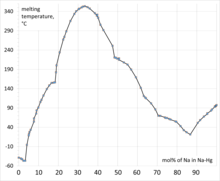Sodium amalgam
[5] The process causes localised boiling of the mercury and for this reason the formation is usually conducted in a fume hood and often performed using air-free techniques, such as synthesis under anhydrous liquid paraffin.Sodium amalgam is a by-product of chlorine made by mercury cell electrolysis.In this cell, brine (concentrated sodium chloride solution) is electrolysed between a liquid mercury cathode and a titanium or graphite anode.Normally this sodium amalgam is drawn off and reacted with water in a "decomposer cell" to produce hydrogen gas, concentrated sodium hydroxide solution, and mercury to be recycled through the process.In principle, all the mercury should be completely recycled, but inevitably a small portion goes missing.

mercurysodiumamalgamintermetallic compoundsweight percentYouTubeNileRedexothermicallyair-free techniquesorganic chemistryreducing agentEmde degradationhigh pressure sodium lampby-productchlorinemercury cell electrolysissodium chlorideelectrolysedcathodetitaniumgraphitehydrogensodium hydroxideGreenwood, Norman N.Butterworth-HeinemannOrganic SynthesesWayback MachineMercury compoundsHg2Br2Hg2Cl2Hg2(NO3)2Hg2CO3Hg2SO4HgNH2ClHg(O2CCH3)2Hg(CN)2Hg(OH)2Hg(NO3)2Hg(SCN)2Hg(CNO)2Hg(Si(CH3)3)2K2HgI4OrganomercuryHg(CH3)2Hg(C2H5)2Hg(C6H5)2HgC6H5CH3CO2HgC6H5OB(OH)2HgC6H5NO3HgC6H5CCl3HgClC6H4CO2HHgOHCH2CHOCH3CH2(NHCO)C36H70HgO4HgOHCH2CHOCH3CH2NHCOC6H4OCH2CO2HNa2HgOHC6HOBrC6H2OBrOCHC6H4CO2HgOC6H2CH3NO2NaHgC2H5SC6H4CO2AmalgamsAl(Hg)Mercury cationsHgCH+3HgC2H+5HgC6H+5